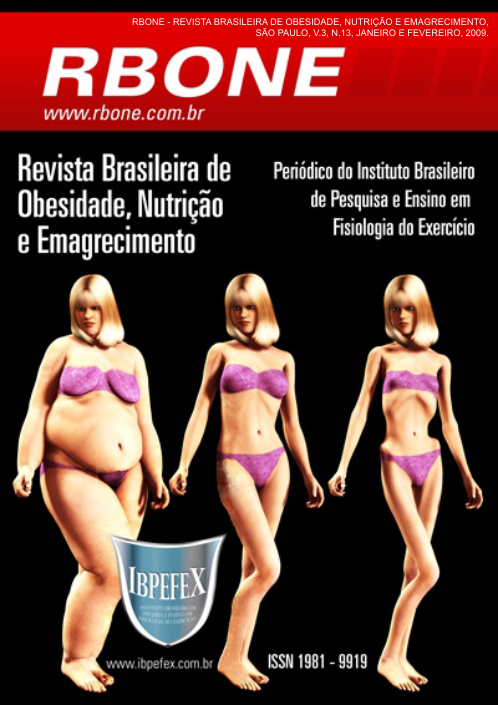Changes in body composition, when there is a follow nutrition practice of physical exercise prescribed and monitored
Abstract
Objective: This study aims to determine the effects of 12 weeks of aerobic and muscle training, changes in body composition and physical abilities, through a case study, an adult woman, obese grade I. Materials and Methods: The study, described as depicting the type of case study, using samples of 1 individual, aged 25, female, obese grade I, sedentary. It was applied to collect data to describe the body composition of the individual, through functional physical evaluation. We assessed the body mass index (BMI), the percentage of fat (% G), measures of circumference and waist-hip ratio (WHR). For nutritional assessment, using the recall method, where the individual reported for 3 consecutive days all that was consumed by assessed in the period of 24h. Results: The results revealed a low level of aggregation of physical fitness with unhealthy eating habits, causing a high percentage of fat. Conclusion: Through the practice of physical activity and lower energy consumption, there is a reverse relation between the consumption of energy versus oxidation, causing a positive energy balance, which will provide a reduction in body weight and consequently reduce the percentage of fat.
References
- Bouchard, C. Atividade física e obesidade. São Paulo. Manole. 2003.
- Carnaval, Paulo Eduardo. Medidas e Avaliação em ciências do esporte. 5º edição, Rio de Janeiro. Editora Sprint. 2002.
- Costa, R.F. Composição corporal-teoria e prática da avaliação. São Paulo. Manole, 2001.
- Fernandes Filho, J. A prática da avaliação física. 2. ed. Rio de Janeiro: Shape, 2003.
- Guedes, D.P.; Guedes, J.E.R. Atividade física, composição da dieta e gordura corporal em indivíduos adultos. Kinesis, Num. 18. 1997. p. 7-21.
- Guedes, D.P.; Guedes, J.E.R.P. Controle do peso corporal: composição corporal, atividade física e nutrição. 2. ed. Rio de Janeiro. Shape. 2003.
- Guedes, D.P.; Guedes, J.E.R.P. Crescimento, composição corporal e desempenho motor de crianças e adolescentes. São Paulo: C.L.R. Balieiro, 1997.
- Hettinger, T.; Hollman, W. Medicina do Esporte: Fundamentos anatômico-fisiológicos para a prática esportiva. Ed. 4. São Paulo. Editora Manole. 2005.
- Mcardle, W.D.; Katch, F.I.; Katch, V.L. Fisiologia do Exercício, Energia, Nutrição e Desempenho. 4º edição. Rio de Janeiro. Editora Guanabara Koogan. 1998.
- Monteiro, W.D. Personal Training - Manual para Avaliação e Prescrição de Condicionamento Físico. 3º edição. Rio de Janeiro. Editora Sprint. 2001.
- Nahas, M. V. Atividade Física, Saúde e Qualidade de vida. Rio de Janeiro. Editora Midiograf. 2001.
- Nunes, M.M.A.; José Natal F..; A.J. Bezerra. Excesso de peso, atividade física e hábitos alimentares entre adolescentes de diferentes classes econômicas em Campina Grande (PB).
- Pitanga, F.J.G. Testes, medidas e avaliação em educação física e esportes. 3. ed. São Paulo. Phorte. 2004.
- Pollock, M.L.; Wilmore, J.H. Exercícios na Saúde e na Doença, Avaliação e Prescrição para Prevenção e Reabilitação. 2ª edição. 1993.
- Quetelet A. Physique Sociale: ou, essai sur le développement des facultés de l ́homme. Brussels, Belgium: C. Muquardt; 1869.
- Rinaldi, A. E. M.; e colaboradores. Contribuições das práticas alimentares e inatividade física para o excesso de peso infantil. Rev. Paul. Pediatr. Vol. 26. Num. 3. 2008. p. 271-277.
- Rocha, P.E.C.P. Medidas de Avaliação em Ciências do Esporte. 4º edição. Rio de Janeiro. Editora Sprint. 2000.
- Rozowski, J.; Arteaga, A. The problem of obesity and its shocking characteristics in Chile. Rev Med Chile. Vol. 125. 1997. p. 1217-24.
- World Health Organization. Physical status: the use and interpretation of anthropometry. Geneva. WHO. 1995.
Authors who publish in this journal agree to the following terms:
- Authors retain the copyright and grant the journal the right of first publication, with work simultaneously licensed under the Creative Commons Attribution License BY-NC which allows the sharing of the work with acknowledgment of the authorship of the work and initial publication in this journal.
- Authors are authorized to enter into additional contracts separately for non-exclusive distribution of the version of the work published in this journal (eg, publishing in institutional repository or book chapter), with acknowledgment of authorship and initial publication in this journal.
- Authors are allowed and encouraged to post and distribute their work online (eg, in institutional repositories or on their personal page) at any point before or during the editorial process, as this can bring about productive change as well as increase impact and impact. citation of published work (See The Effect of Free Access).






